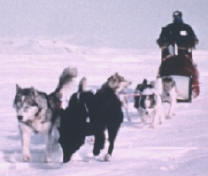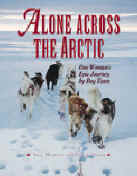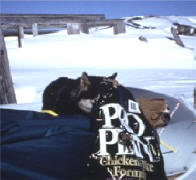|
|
"What
one person can do, another can do." -- David Mamet |
|
Alone Across the Arctic:
A journey from Barrow, Alaska to Repulse Bay in Canada's Nunavut
Territory
|
 |
|
Pam
and her team, crossing the Arctic in her 1993-94 expedition. |
|
Pam Flowers and her eight-dog team left Barrow,
Alaska alone in an attempt to cross the frozen roof of the world. The plan was to retrace the route of Danish explorer Knud Rasmussen's
portion of the fifth Thule Expedition. Their destination, the tiny, remote
Canadian Arctic village of Repulse Bay, lay 2500 miles to the east.
The Fifth Thule Expedition was composed of seven Danish scientists of
various disciplines and a contingent of Greenland Natives who worked as
dog drivers, hunters, and interpreters. The expedition arrived in
Repulse Bay in 1922, intent on documenting Inuit history and culture.
|
|
In May, 1923, Rasmussen left Repulse Bay in the company of a Native
Greenland woman named Anarulunguaq and her cousin, a man named Miteq.
The majority of their trek took them across 2500 miles of the Northwest
Passage to Barrow, Alaska thirteen months later.
| Pam Flowers and
her dog team followed the route of the Fifth Thule Expedition as
closely as possible, traveling west to east. Anarulunguaq was
the first woman to complete this entire route. Pam Flowers
hoped to become the second woman known to complete the entire
route, the first woman and first American to do it solo.
Pam and her dogs visited Kaktovik, Alaska and the Canadian
arctic communities of Tuktoyaktuk, Paulatuk, Coppermine, Bay Chimo, Cambridge
Bay, Gjoa Haven, Pelly Bay and Repulse Bay.
After traveling 2,000 miles, enduring darkness, isolation, cold,
one of the stormiest winters on record, a polar bear encounter, and
melting,
flooded sea ice, the expedition was temporarily halted when break-up
arrived in the Arctic over five weeks early. |
Pam's book, published by the
Graphic Arts Center Publishing Co.

A map of
Pam's
route. |
|

Sojo sneaks a snack while
training on
the North Slope of Alaska in 1997. |
Upon reaching Gjoa Haven, for the first time on this journey,
Inuit people advised Pam not to go on because the sea ice was unsafe for
travel. Now marooned, she reluctantly took their advice and spent the
next five and a half months living on King
William Island in Gjoa Haven with the Qitsualik's, a family of five
Inuit people.After freeze-up the expedition
set out from Gjoa Haven and Pam and her dogs toured the area. Finally, they turned east once more and
sledded across Rasmussen Basin
and the Boothia Peninsula to Pelly Bay where Pam enjoyed a unique
Inuit-style Christmas full of games and celebrations.
|
Pam and her team arrived safely
at their destination of Repulse Bay. All eight dogs arrived in Repulse Bay in excellent health and good
spirits. Pam Flowers had successfully completed the first solo by
a woman and the first solo by an American across 2,500 miles of Arctic
America.
|
|